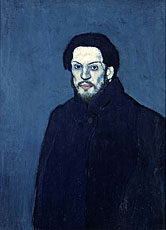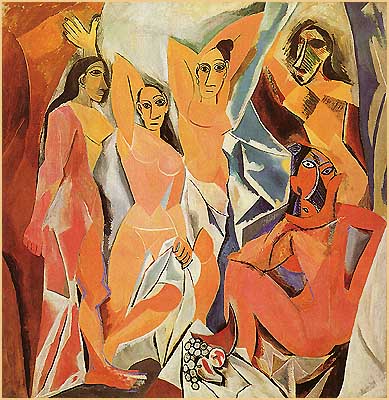

Picasso.
Son of a
drawing instructor, Picasso learned the secrets of this technique
early on and, before long, had mastered it perfectly. When he was
10 years old, his family moved to La Coru�a, where Picasso
studies brilliantly at the Fine Arts School. By the time he
arrived in Barcelona (1895), Picasso already drew exceptionally
well and was a good painter. Within the cultural atmosphere at
this city, he found the platform he needed to keep going and his
art and his creativity found the d efinitive style they
needed. The factors that helped him do so were many and varied:
his classes at La Ljotja, where he heard about El Greco,
symbolists and all sorts of artists and tendencies, round tables
at Els Quatre Gats, where there were heavy discussions on all the
era's "isms" and where he held his first public
exhibition. This was also where he met many artists who were up
on the latest trends in art: Mir, Nonell, Gonzalez, Gargallo and
Manolo Torres Garcia. Barcelona was also the city in which he
made close friends, such as Casagemas, Sabartes, Vidal Ventosa
and Soto. A clear example of Picasso's ties to Barcelona was the
creation of his own museum, which was suggested by Picasso
himself. He contributed to enriching the museum's collections
through different donations. The museum itself was founded with
collections donated by Sabartes, who was Picasso's friend and
personal secretary. In 1900, he went to Paris with his friend
Casagemas, and they took the studio recently vacated by another
Catalonian painter, Isidre Nonell. There he became familiar with
impressionist works. He was surrounded by difficulty, and the
suicide of his friend Casagemas had a profound impact on the
young Picasso. Under these circumstances, he began the works of
his so-called "blue period", which he would fully
develop upon his return to Barcelona in 1903-1904. Once he
definitively settled in Paris, he began his "rose
period", in which the sadness and misery of his blue period
was substituted for the more lively world of theater and circus.
In 1906, he returned to Catalonia, to G�sol, where he stayed for
three months. Here his works seemed to be imbued with the colors
of Mediterranean landscapes, and he began the cubist approach he
would later develop in Paris. He was again refreshed by a stay in
Horta d'Ebre (Catalonia, 1909) and Cadaqu�os (1910). Around
1913, Picasso began to include collages in his cubist works and
became enthused by this new technique, which allowed him to give
his work new textures. Three years later, he began a new experien
efinitive style they
needed. The factors that helped him do so were many and varied:
his classes at La Ljotja, where he heard about El Greco,
symbolists and all sorts of artists and tendencies, round tables
at Els Quatre Gats, where there were heavy discussions on all the
era's "isms" and where he held his first public
exhibition. This was also where he met many artists who were up
on the latest trends in art: Mir, Nonell, Gonzalez, Gargallo and
Manolo Torres Garcia. Barcelona was also the city in which he
made close friends, such as Casagemas, Sabartes, Vidal Ventosa
and Soto. A clear example of Picasso's ties to Barcelona was the
creation of his own museum, which was suggested by Picasso
himself. He contributed to enriching the museum's collections
through different donations. The museum itself was founded with
collections donated by Sabartes, who was Picasso's friend and
personal secretary. In 1900, he went to Paris with his friend
Casagemas, and they took the studio recently vacated by another
Catalonian painter, Isidre Nonell. There he became familiar with
impressionist works. He was surrounded by difficulty, and the
suicide of his friend Casagemas had a profound impact on the
young Picasso. Under these circumstances, he began the works of
his so-called "blue period", which he would fully
develop upon his return to Barcelona in 1903-1904. Once he
definitively settled in Paris, he began his "rose
period", in which the sadness and misery of his blue period
was substituted for the more lively world of theater and circus.
In 1906, he returned to Catalonia, to G�sol, where he stayed for
three months. Here his works seemed to be imbued with the colors
of Mediterranean landscapes, and he began the cubist approach he
would later develop in Paris. He was again refreshed by a stay in
Horta d'Ebre (Catalonia, 1909) and Cadaqu�os (1910). Around
1913, Picasso began to include collages in his cubist works and
became enthused by this new technique, which allowed him to give
his work new textures. Three years later, he began a new experien ce in his creative
process by participating in Serge Diaghilev's Russian Ballet,
which opened in Barcelona in 1917 for an extended stay. This
contact with the theather world, as well as a trip to Italy,
brought him back to figurative painting with a new interest in
characters from the Italian comedy. He alternated this interest
with his investigation into cubism. During the 20's, he made
different contacts with the surrealists. The culmination of this
contact was a cover he did for the magazine Minotaure. The
minotaur, which had already made an appearance in his production,
became a prevalent subject and, together with bullfighting,
became the subject of many of his works. During the Spanish civil
war (1936-1939), the artist took the side of the Spanish
Republic, which appointed him director of the Prado Museum. His
indignation at the brutal bombing of Guernica insipired the large
mural (1937) he painted in honor of the city. During the 40s, he
began to make ceramics, which later turned to an interest in
sculpture from scraps, which he began making in the 50's. Pablo
Picasso continued producing all types of works using all types of
bases and techniques. His incessant creativity characterized him,
making him one of the great geniuses of our time.
ce in his creative
process by participating in Serge Diaghilev's Russian Ballet,
which opened in Barcelona in 1917 for an extended stay. This
contact with the theather world, as well as a trip to Italy,
brought him back to figurative painting with a new interest in
characters from the Italian comedy. He alternated this interest
with his investigation into cubism. During the 20's, he made
different contacts with the surrealists. The culmination of this
contact was a cover he did for the magazine Minotaure. The
minotaur, which had already made an appearance in his production,
became a prevalent subject and, together with bullfighting,
became the subject of many of his works. During the Spanish civil
war (1936-1939), the artist took the side of the Spanish
Republic, which appointed him director of the Prado Museum. His
indignation at the brutal bombing of Guernica insipired the large
mural (1937) he painted in honor of the city. During the 40s, he
began to make ceramics, which later turned to an interest in
sculpture from scraps, which he began making in the 50's. Pablo
Picasso continued producing all types of works using all types of
bases and techniques. His incessant creativity characterized him,
making him one of the great geniuses of our time.
